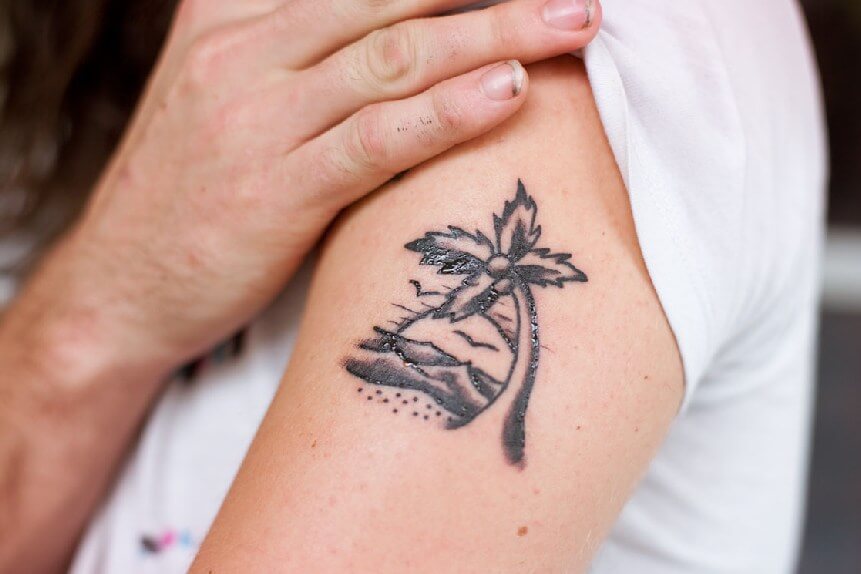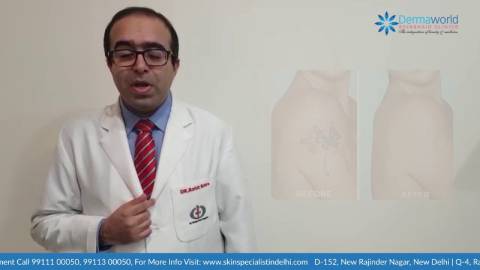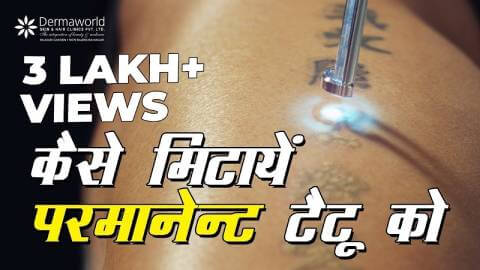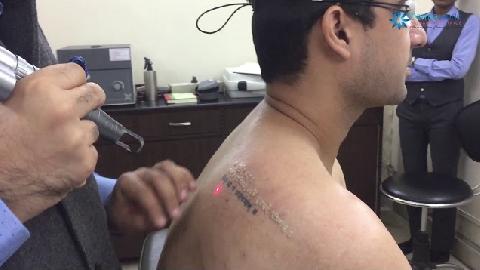
Pre-treatment consultation
- Analysis of skin tone, type, texture, and color.
- The color and amount of the ink used is analyzed and evaluated.
- The layers of tattoo present in the skin, and the location of the tattoo on the body area.
- The pre-existing scarring is also taken into consideration.
- The skin reaction to the laser test is also conducted.
Best Skin Doctor for Laser Tattoo Removal in Delhi, India
The art of body decoration using tattoos is a part of human culture since ages, and in this technique, the ink is placed beneath the top layer of the skin or into the superficial or mid-dermis layer. Nowadays, cosmetic tattoos are also administered as a substitute of the liner, to replace the lost eyebrows, cover birthmarks and scars. Sometimes, tattooing also occurs as a result of injury or trauma to the skin. If someone is at the tattoo regret phase and unhappy with the appearance of their tattoos, or the tattoo has become blurred or faded, then laser tattoo removal can provide promising results. The laser used for tattoo removal in Delhi at Dermaworld Skin Clinic is the safest and one of the most preferred tattoo removal techniques. The technique is bloodless and effective for removing complex, stronger, and any types of tattoos.
Many people use salt, salabrasion, sandpaper, and also opt for other traditional methods to get rid of tattoos, but all these methods can result in bleeding, necrosis of tissues, inflammation, loss of skin pigmentation, and scarring in the treated area. These destructive methods must not be performed to remove tattoos as they also pose a significant risk of causing skin infection and hypertrophic scarring.
How does laser remove tattoo? (The mechanism)
The wavelength emitted by the laser passes through the skin and breaks up the tattoo ink present underneath the skin, and this method is performed in a staged manner.
Different wavelengths of laser are used to break the different colors of the ink. The dark (black) tattoo ink is the easiest to remove. The laser works by breaking the ink pigment by targeted-intensity light beam that removes the tattoo without leaving the scars behind. Numerous sessions are required to remove the multicolored tattoos.
At Dermaworld Skin Clinics we use Active Q-Switched laser which consists of three types of lasers, including Nd:YAG, Alexandrite, and Ruby. Each type of laser provides with impressive results and targets different color using different wavelength. This method does not cause harm to the skin.
The removal of tattoos requires the study of absorbance characteristic of the tattooed skin, and the use of dermal clearing agents and the pulse duration of lasers to achieve the desired results.
Procedure for laser tattoo removal
1. The area to be treated is cleaned, and the numbing cream or local anesthetic is administered.
2. The eye shields are provided to protect the eyes.
3. The pulse of laser energy is applied to the tattoo and it shatters the tattoo ink.
4. In the case of multicolored tattoos, different lasers and wavelengths are delivered to remove them.
5. The lasers break the ink particles, and the body's immune system removes the ink particles using the phagocytosis process.
5. Immediately after the treatment, ice-pack is applied to soothe the treated area.
6. Antibiotic ointment and bandages are applied to protect the treated area.
* This method only removes the target structures and does not cause any damage to the surrounding tissues.
* Repeated sessions are required as per the length, type, and pigments present in the tattoo.
Book An Appointment
ALL CLINICS CLOSED ON SUNDAY
Aftercare
Aftercare precautions are critical to ensure successful laser tattoo removal, and this helps the body to heal faster after each treatment.
- Blistering is common after laser treatment as it is a part of the body's natural healing process. Do not touch and rupture the blisters, and apply the prescribed medication in the blister affected area.
- Avoid picking scabs, and do not perform shaving in the treated area, as it can cause the removal of scabs.
- Avoid hot baths, hot showers, and swelling to prevent the chances of infection.
- Avoid strenuous activities for about 2-3 days after laser tattoo removal treatment.
- Protect the treated area from the sun and dust.
- Use sunblock as directed by the dermatologist.
- Cover the treated area bandaged with sterile gauze and always apply the antibiotic ointment.
- Keep the treated area dry and clean during the healing period.
Healing is completed after 4-10 days after the treatment, depending upon the aftercare and the level of treatment provided. If the aftercare is not appropriately provided it can result in a change in skin texture, infection, and unwanted side effects may occur.
Side effects of laser tattoo removal treatment
Every medical treatment is associated with some side effects, and if the treatment is provided by expert hands, then the occurrence of any side effects are minimal to none. In small tattoos, they are negligible.
- Redness and inflammation in the treated area.
- Tenderness and mild swelling may occur if the size of the tattoo is larger.
- Risk of infection and scarring.
- Crusting, dryness, and scabbing.
- Formation of blisters and minor bruises may occur, and they will heal after 2-3 days after treatment.
Results and benefits of laser tattoo removal treatment
- The treatment is safe and convenient.
- Minimum to no downtime.
- Significant fading of the tattoo with successive sessions.
Frequently Asked Questions
Laser tattoo removal technology is one of the fastest methods to remove a tattoo. A Q-switched laser is effectively used by many dermatologists to remove a tattoo, including Nd: YAG, Alexandrite, and Ruby. Each laser provides impressive results. It is the fastest and most effective way to remove any type of tattoo. This method does not cause any harm to the skin, and the laser heat breaks down the tattoo pigment present in the deep skin layers. Many people often opt for home remedies to remove a tattoo, but these methods can result in bleeding or necrosis of tissues and inflammation. Hence, it is necessary to consult a dermatologist for the best results.
Unwanted tattoos can be removed effectively and safely with advanced lasers (focused light energy). The laser light travels along different wavelengths and breaks down the different colors present in the tattoo. The fragmented color is then absorbed by the body and removed naturally by the body’s immune system. The success rate of tattoo removal also depends on the color and the age of the tattoo. Ruby laser can remove blue and black inks, whereas Nd: YAG can remove red and other colored inks. With the help of advanced laser, it is not hard to get a tattoo removed. Laser tattoo removal is the safest method, which diminishes the appearance of the tattoo to 90%.
Tattoo cannot be removed entirely with natural homemade methods. This can cause scabbing and can be hazardous for health. There are various types of technologies available that help to remove unwanted tattoos effectively. But they all must be performed by a skin doctor to achieve safe and best results. Laser tattoo removal is one such effective and most frequently used method that is safe and effective for removing any type of tattoos. Different medical options, such as cryosurgery and other techniques, are also effective in removing a tattoo. Laser technology also encourages new skin cell recreation and helps in the growth of healthy and smooth surfaces. Homemade remedies pose a significant risk of causing skin infection and hypertrophic scarring. The traditional methods of tattoo removal results in bleeding, inflammation, and scarring in the treated area.
Laser tattoo removal is considered the most safe method of removing tattoos as compared to many other tattoo removal methods such as excision, dermabrasion. Laser tattoo removal is safe because laser treatment selectively treats the pigment in the tattoo. This is a simple and painless procedure that is performed with high powered lasers and also removes the permanent tattoo ink effectively. The treatment is painless and is performed under the effect of numbing cream. One can see the best results from the very first session and significant fading of the tattoo with successive sessions.
A tattoo cannot be removed in one session, and after each session, the tattoo will become progressively lighter. The number of sessions depends on various factors, such as the color of the tattoo, age of the tattoo, and skin tone. Smaller tattoos will require fewer pulses, whereas larger ones will require more time to remove them. For colored tattoos, multiple sessions are required to achieve the best results.
The average cost of laser tattoo removal depends on several factors which include:
- The size and location of the tattoo.
- The age of the tattoo and the type of ink used in the tattoo.
- The color of the tattoo (blue ink is easier to remove than colored ink).
- The number of laser tattoo removal sessions.
- Type of lasers used to remove the tattoo.
- Location of clinic.
- Experience of the doctor.




